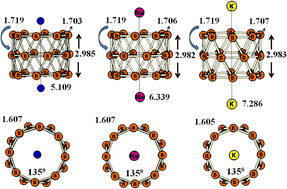Theoretical investigations on the structures and electronic and optical properties of neutral and anionic M2-doped B24 clusters (M = Li, Na, and K)†
Abstract
This paper reports a theoretical study on the structures and electronic and optical properties of M2B240/− (M = Li, Na, and K) clusters using the particle swarm optimization (CALYPSO) searching method and density functional theory (DFT) calculations. The lowest energy structures of M2B24 (M = Li, Na, and K) clusters with high symmetry are composed of three stacked ring forms, and two M atoms are located on the axis of the tubular structures. The lowest energy structure of the Li2B24− cluster exhibits an open bowl-shaped structure, while the lowest energy structures of Na2B24− and K2B24− clusters have a double-ring tubular shape. Based on these structures, some electronic properties including charge transfer, bonding character, dipole moment, polarizability, and thermodynamic properties were investigated systematically. In addition, to provide a theoretical basis for the identification and confirmation of studied clusters, the PES, IR, Raman, and UV-visible spectra with different and meaningful characteristic peaks were simulated, which can be considered as the reference for future experimental studies.



 Please wait while we load your content...
Please wait while we load your content...